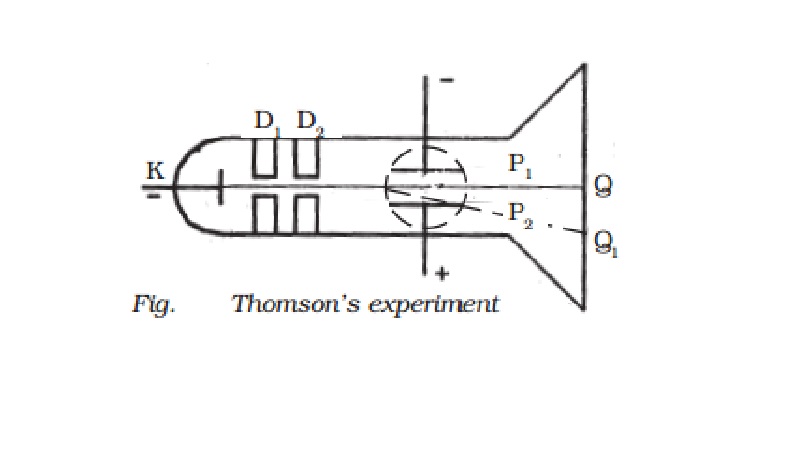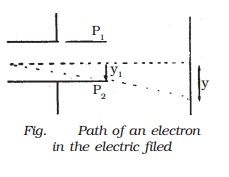Chapter: 11th 12th std standard Class Organic Inorganic Physical Chemistry Higher secondary school College Notes
Thomson's method - Determination of specific charge (e/m) of an electron

Determination
of specific charge (e/m) of an electron - Thomson's method.
In 1887, J.J. Thomson, measured the specific
charge (e/m) of the cathode ray particles. The specific charge is defined as
the charge per unit mass of the particle. Thomson discovered that the value of
(e/m) was independent of the gas used and also independent of the nature of the
electrodes.
Principle
The fact that the cathode rays (electrons) are
deflected by electric and magnetic fields is made use of in this method.
Experimental arrangement
A highly evacuated discharge tube used in this
experiment is as shown in Fig. Cathode rays are produced by the discharge
between the cathode and the anodes D1 and D2. A thin pencil of cathode ray
comes out through fine pin holes in the anode discs. The cathode rays
then pass between two
parallel metal plates P1 and P2 and strike the flat face of the tube. This face
is coated with suitable fluorescent material. A spot of light
is produced at Q But when a potential difference V is applied between P1
and P2, the beam is deflected to point Q1. By the use of
a pair of coils, uniform magnetic field is produced perpendicular to the plane
of the paper and outwards through out the region between P1 P2.

Theory
1. Determination of V
With a given electric intensity between the plates P1
and P2 the magnetic induction B is adjusted until the beam strikes
the screen at the original position Q. Then the downward force Ee due to the
electric field is balanced by the force Bev due to magnetic induction where e
is the charge of the cathode ray particle and v is the velocity of the cathode
rays.
Ee = Bev
V = E / B
……. (1)
2. Determination of e/m
Now the magnetic induction is
switched off. The deflection Q Q1 = y caused by the electric field
alone is measured. At the instant when the cathode rays enter the region
between the plates P1 and P2, initial velocity in the
downward direction u = 0
Acceleration along the downward direction a = Ee/m , where m is the mass of each
cathode ray particle.
Time for which the electron moves in the electric
field t = l/v where l is the length
of either of the plates and v is the velocity of the electron.
The deflection produced on the cathode rays along the
downward direction in the electric field is given by
y1 = ½ (Ee/m) (l/v)2 …… (2)
Substituting for v from equation (1) in equation (2)
we get
y1 = 1/2 (Ee/m)(l2/E2)B2
= ½ ( el2B2 ) / (mE)
The displacement of the spot of
light on the screen is given by (Fig)

y = K y1, where K is a
constant determined by the geometry of the discharge tube. Substituting for y1
we get,
y = K (1 e l2 B2)/2mE …….. (3)
e/m = 2yE / K l2 B2
……….. (4)
By substituting the known values
in the above relation e/m of an electron can be calculated. The value of e/m
calculated using this experiment was found to be 1.7592 × 1011 C kg-1
Note: The value of e/m of an
electron can also be calculated, by applying uniform magnetic field
perpendicular to the path of the electron.
Related Topics